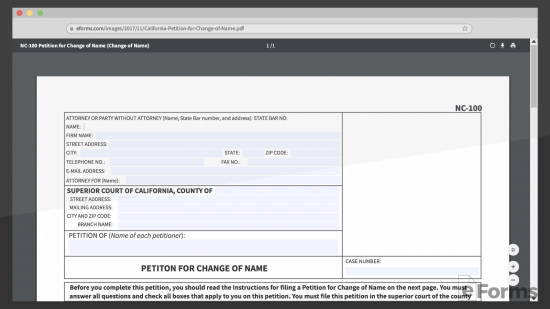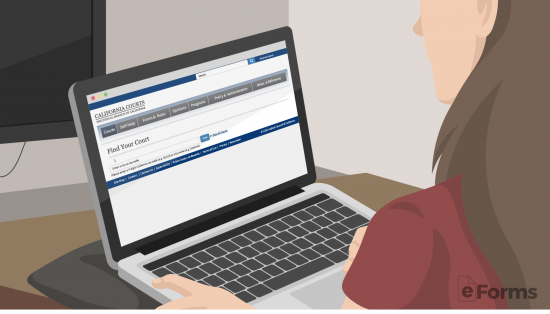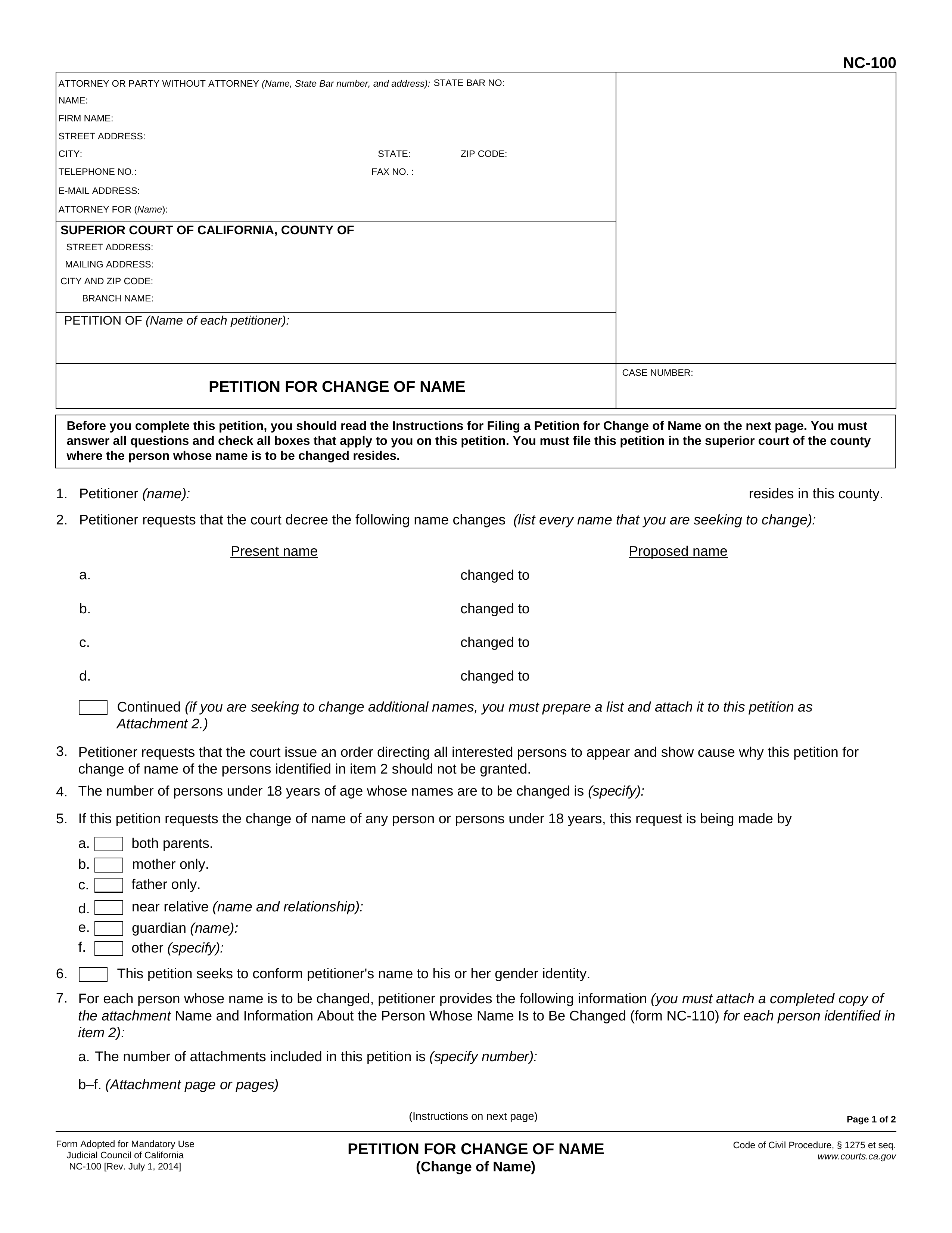Updated August 14, 2023
California name change forms allow a person above the age of 18 to request a name change. The forms must be submitted, along with a filing fee and accompanying paperwork, to a California superior court located in the individual’s county of residence. If a judge approves the request, the individual will be issued a decree to serve as legal proof of their name change.
Name Change After Marriage
You may change your last name at the time your licensing documents are being signed. To ensure the legality of the change, contact the Social Security Administration and a local California DMV to see if they will accept your marriage license as proof of the change. They may demand additional verification in the form of a court order.
To obtain a copy of your marriage license, file a request with the California Department of Public Health and submit the $17 filing fee. You can amend your marriage license if your name was not changed at the time of marriage.[1]
Name Change After Divorce
If your divorce has not been finalized, you can make a request before the court to restore your prior name. This can be accomplished by entering your former name in section 4(f) of your Judgment, also known as a divorce decree. This document will prove that you changed your name legally. If your name is being changed to anything other than your former name, you must complete the standard filing of a Petition for Change of Name.
If your divorce is final and was filed in California, contact a court clerk in your county and provide them with your divorce details, including a Marital Settlement Agreement. In addition, provide a copy of your completed Notice of Entry of Judgment and an Ex Parte Application for Restoration of Former Name After Entry of Judgment and Order.
How to Change Your Name (9 steps)
- Complete Petition for Change of Name
- Complete Attachment to Petition
- Complete Order to Show Cause
- Complete Civil Case Cover Sheet
- Check for Local Forms
- Review Filings
- File Forms with Superior Court
- Publish Court Order
- Attend Hearing
Step 1 – Complete Petition for Change of Name

Complete a Petition for Change of Name. The required information includes your personal details, the name of your attorney (if applicable), superior court location, and the proposed new name. Make two copies of the form after it has been completed.
Step 2 – Complete Attachment to Petition

Complete an Attachment to Petition for Change of Name and include it with your Petition for Change of Name. This document will be used to provide the court with some additional personal information and to describe the reason for the name change. Make two copies of the form.
Step 3 – Complete Order to Show Cause for Change of Name

Also to be included with your filings is the Order to Show Cause for Change of Name. Much like the Petition for Change of Name, this document will inform the court of your personal details as well as the proposed new name. Fill out the form and make two copies.
Step 4 – Complete Civil Case Cover Sheet

Fill out the Civil Case Cover Sheet and attach it to your completed documents. Under “Miscellaneous Civil Petition” in section (1) of the form, select “Other petition (not specified above) (43).” Make two copies of the cover sheet once completed.
Step 5 – Check for Local Forms

Depending on the county where you reside, you may be required to fill out additional forms and submit them with your filings (e.g. background check form, fingerprint card). Contact your local superior court to see if any other documents are needed. Make two copies of all additional paperwork.
Step 6 – Review Filings

It is recommended that you contact a California family law facilitator or self-help center (if available in your county) to have your filings reviewed. These organizations will be able to ensure that you have filled out your paperwork correctly, and they will provide you with further information on the filing requirements in your county.
Step 7 – File Forms with the Superior Court

Submit your filing package to a superior court located in your county of residence. File your original documents with the clerk and request that each copy be certified. Refer to the copy of your Order to Show Cause for Change of Name, as it will contain information on your hearing date, time, and department number.
A filing fee of $435 will be needed to process your paperwork, though this rate may vary in certain counties due to local courthouse surcharges. If you cannot afford the fee, ask the clerk for a fee waiver.[2][3]
Step 8 – Publish Court Order

California law requires that you publish your Order to Show Cause for Change of Name in a newspaper of general circulation once a week for four consecutive weeks. Your local superior court should have a list of newspapers that publish legal notices. After the notice has been published, ask the newspaper for proof of publication.
Certain scenarios will allow you to bypass the publication requirement.[4] The following list shows the instances where publishing is not required:
- If you are changing your name to affirm your gender identity
- If you are in the State Witness Program
- If you are in the address confidentiality program and your name is being changed to avoid domestic violence, stalking, or if you are a victim of sexual assault
Step 9 – Attend Hearing

Go to your court hearing on the date specified on your Order to Show Cause for Change of Name. Be sure to bring proof of publication (if required) as well as a Decree Changing Name form. If your request for a change of name is approved, the judge will sign the decree and return it to you. Ask a court clerk to make a certified copy of the decree; this document will serve as proof that your name has been changed legally.
Driver’s License
In order to change the name on your California driver’s license, you must notify the Social Security Administration (SSA) and update your social security card. You can do this by filling out an Application for a Social Security Card and delivering it in person or by mail to an SSA location in your county.
Included with the application must be the following documents:
- Proof of name change, such as your marriage certificate, divorce decree, or court order
- Proof of identity (see list of accepted documents)
- Proof of citizenship, such as your U.S. birth certificate or certificate of citizenship
All of the documents listed above must be originals or certified copies. Your new social security card will be mailed to you after the SSA has processed your application.
After updating your social security card, visit a California DMV location and submit a Driver’s License or Identification Card Application. You must also provide an original or certified copy of your legal name change document and pay a $33 licensing fee.[5] Your new card will be sent to you by mail within three to four weeks.
Voter Registration
To change the name on your voter registration, complete a new California Voter Registration Application online. Alternatively, you can obtain a Voter Registration Application from the local county elections office.


